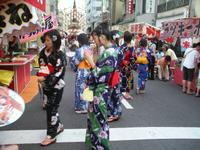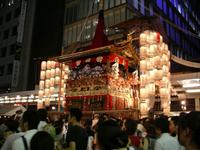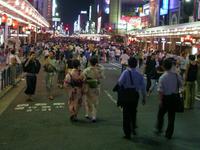Gion Matsuri, Kyoto Summer Festival
Gion Matsuri is one of Kyoto's most famous festivals. It culminates in a parade of huge floats on the 17th of July. We enjoyed all of the festivities leading up to the parade, but weren't able to see the parade itself since we flew home on the 17th.Gion Matsuri is several hundred years old. It originated as a way to appease the gods who were bringing famine and plague to Kyoto. The main parade on the 17th involves 32 Yama and Hoko floats. The Hoko floats are two stories and usually have a bunch of boys playing traditional instruments on the second story. Although they have wheels (as tall as me!), it still takes about 80 men to push and pull the Hoko floats around the parade and turning the floats is a major feat of engineering. Each float is sponsored by a particular neighborhood or merchant organization.
 The three days leading up to the parade are called the yoi-yoi-yoi-yama, yoi-yoi-yama, and yoi-yama (which roughly translates to "the eve of the eve of the eve before the parade" and so on.) The streets of the central shopping area of Kyoto are closed to vehicles during this time and the whole area becomes a huge street festival. The total area was about five by ten blocks (big blocks). The side streets contained kids games, food stalls, drink stands, and souvenir merchants. The main focus of the "yoi-yama" is the display of the floats that will be paraded around on the 17th. Although we missed the parade, we still got to see quite a few of the floats just by walking around the street festival.
The three days leading up to the parade are called the yoi-yoi-yoi-yama, yoi-yoi-yama, and yoi-yama (which roughly translates to "the eve of the eve of the eve before the parade" and so on.) The streets of the central shopping area of Kyoto are closed to vehicles during this time and the whole area becomes a huge street festival. The total area was about five by ten blocks (big blocks). The side streets contained kids games, food stalls, drink stands, and souvenir merchants. The main focus of the "yoi-yama" is the display of the floats that will be paraded around on the 17th. Although we missed the parade, we still got to see quite a few of the floats just by walking around the street festival. The huge hoko floats had 15th century Turkish and Dutch tapestries hanging off of them and lots of paper lanterns. Many of them had a tall pole or tree stuck on top such that they ended up looking like small towers.
The huge hoko floats had 15th century Turkish and Dutch tapestries hanging off of them and lots of paper lanterns. Many of them had a tall pole or tree stuck on top such that they ended up looking like small towers.My favorite part of the festival was that about 1/3 of the young women (and a few men and children also) wore yukata, light cotton kimono worn in the summer. The yukata were very colorful and definitely added to the festive atmosphere.
 We greatly enjoyed seeing this traditional aspect of Japanese culture, but by the third day, the "yoi-yama", it was so crowded that we didn't stay too long. The police had to designate certain side streets as one-way (for foot traffic!) because it was so packed.
We greatly enjoyed seeing this traditional aspect of Japanese culture, but by the third day, the "yoi-yama", it was so crowded that we didn't stay too long. The police had to designate certain side streets as one-way (for foot traffic!) because it was so packed.

0 Comments:
Post a Comment
<< Home